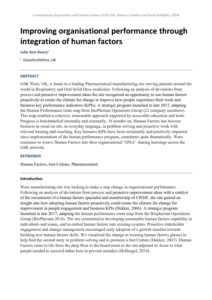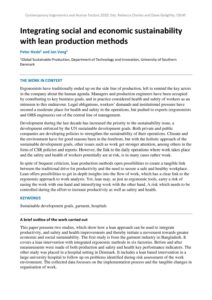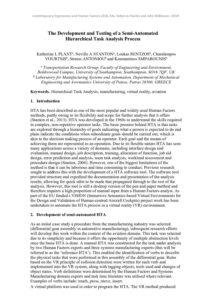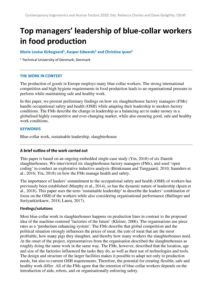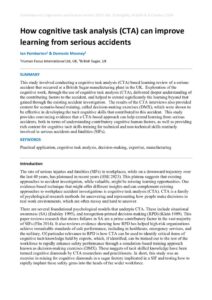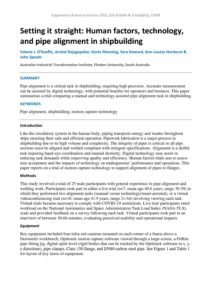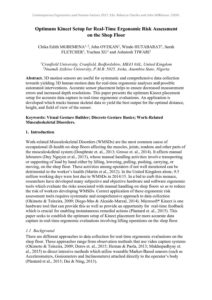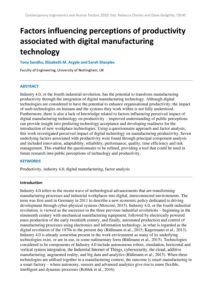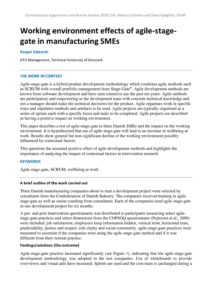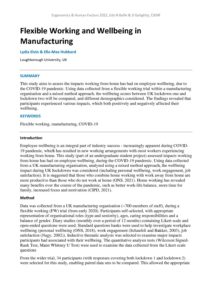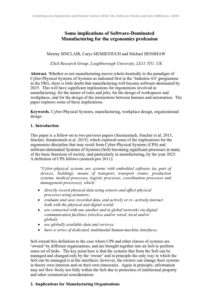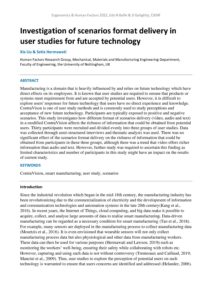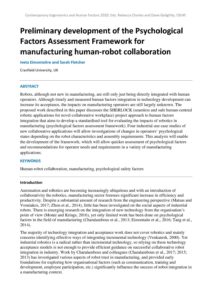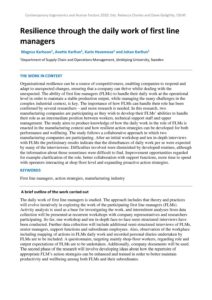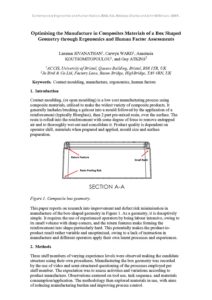Manufacturing
Improving organisational performance through integration of human factors
| Document | Author Julie Ann Avery |
| Abstract GSK Ware, UK, is home to a leading Pharmaceutical manufacturing site serving patients around the world in Respiratory and Oral Solid Dose medicines. Following an analysis of deviations from process and proactive improvement ideas the site recognised an opportunity to use human factors proactively to create the climate for change to improve how people experience their work and business key performance indicators (KPIs). A strategic program launched in late 2017, adapting the Human Performance route map from BioPhorum Operations Group (22 company members). This map enabled a cohesive, measurable approach supported by accessible education and tools. Progress is benchmarked internally and externally. 18 months on, Human Factors has become business as usual on site, in everyday language, in problem solving and proactive work with relevant training and coaching. Key business KPIs have been sustainably and positively impacted since implementation of the human performance program, sometimes quite dramatically. Ware continues to weave Human Factors into their organisational “DNA” sharing learnings across the GSK network. |
Integrating social and economic sustainability with lean production methods
| Document | Author Peter Hasle and Jan Vang |
| Abstract Ergonomists have traditionally ended up on the side line of production, left to remind the key actors in the company about the human agenda. Managers and production engineers have been occupied by contributing to key business goals, and in practice considered health and safety of workers as an intrusion to this endeavour. Legal obligations, workers’ demands and institutional pressure have secured a moderate place for health and safety in the operations, but pushed to experts (ergonomists and OHS engineers) out of the central line of management. Development during the last decade has increased the priority to the sustainability issue, a development enforced by the UN sustainable development goals. Both private and public companies are developing policies to strengthen the sustainability of their operations. Climate and the environment have for good reasons been in the forefront, but with the holistic approach of the sustainable development goals, other issues such as work get stronger attention, among others in the form of CSR policies and reports. However, the link to the daily operations where work takes place and the safety and health of workers potentially are at risk, is in many cases rather weak. In spite of frequent criticism, lean production methods open possibilities to create a tangible link between the traditional drive for productivity and the need to secure a safe and healthy workplace. Lean offers possibilities to get in-depth insights into the flow of work, which has a clear link to the ergonomic approach to work analysis. Yet, lean may, as just as ergonomic tools, carry a risk of easing the work with one hand and intensifying work with the other hand. A risk which needs to be controlled during the effort to increase productivity as well as safety and health. |
The Development and Testing of a Semi-Automated Hierarchical Task Analysis Process
| Document | Author Katherine L PLANT, Neville A STANTON, Loukas RENTZOS, Charalampos VOURTSIS, Stratos ANTONIOU and Konstantinos SMPAROUNIS |
| Abstract |
Top managers’ leadership of blue-collar workers in food production
| Document | Author Marie Louise Kirkegaard, Kasper Edwards and Christine Ipsen |
| Abstract The production of goods in Europe employs many blue-collar workers. The strong international competition and high hygiene requirements in food production leads to an organisational pressure to perform while maintaining safe and healthy work. In this paper, we present preliminary findings on how six slaughterhouse factory managers (FMs) handle occupational safety and health (OSH) while adapting their leadership to modern factory conditions. The FMs describe the change in leadership as a balancing act to make money in a globalised highly competitive and ever-changing market, while also ensuring good, safe and healthy work conditions. |
How cognitive task analysis (CTA) can improve learning from serious accidents
| Document | Author Ian Pemberton & Domonic Mooney |
| Abstract This study involved conducting a cognitive task analysis (CTA) based learning review of a serious accident that occurred at a British Sugar manufacturing plant in the UK. Exploration of the cognitive work, through the use of cognitive task analysis (CTA), delivered deeper understanding of the contributing factors to the accident, and helped to extend significantly the learning beyond that gained through the existing accident investigation. The results of the CTA interviews also provided content for scenario-based training, called decision-making exercises (DMX), which were shown to be effective in developing the tacit cognitive skills that contributed to this accident. This study provides convincing evidence that a CTA-based approach can help extend learning from serious accidents, both in terms of understanding contributory cognitive human factors, as well as providing rich content for cognitive tacit skills training for technical and non-technical skills routinely involved in serious accidents and fatalities (SIFs). |
Setting it straight: Human factors, technology, and pipe alignment in shipbuilding
| Document | Author Valerie J. O’Keeffe, Arvind Rajagopalan, Kosta Manning, Sara Howard, Ann-Louise Hordacre & John Spoehr |
| Abstract Pipe alignment is a critical task in shipbuilding, requiring high precision. Accurate measurement can be assisted by digital technology, with potential benefits for operators and business. This paper summarises a trial comparing a manual and technology-assisted pipe alignment task in shipbuilding. |
Optimum Kinect Setup for Real-Time Ergonomic Risk Assessment on the Shop Floor
| Document | Author Chika Edith MGBEMENA, John OYEKAN, Windo HUTABARAT, Sarah FLETCHER, Yuchun XU and Ashutosh TIWARI |
| Abstract 3D motion sensors are useful for systematic and comprehensive data collection towards yielding 3D human motion data for real-time ergonomic analyses and possible automated interventions. Accurate sensor placement helps to ensure decreased measurement errors and increased depth resolutions. This paper presents the optimum Kinect placement setup for accurate data capture in real-time ergonomic evaluations. An application is developed which tracks human skeletal data to yield the best output for the optimal distance, height, and field of view of the sensor. |
Factors influencing perceptions of productivity associated with digital manufacturing technology
| Document | Author Tony Sandhu, Elizabeth M. Argyle and Sarah Sharples |
| Abstract Industry 4.0, or the fourth industrial revolution, has the potential to transform manufacturing productivity through the integration of digital manufacturing technology. Although digital technologies are considered to have the potential to enhance organisational productivity, the impact of such technologies on humans and the systems they work within is not fully understood. Furthermore, there is also a lack of knowledge related to factors influencing perceived impact of digital manufacturing technology on productivity – improved understanding of public perceptions can provide insight into predicting technology acceptance and developing readiness for the introduction of new workplace technologies. Using a questionnaire approach and factor analysis, this work investigated perceived impact of digital technology on manufacturing productivity. Seven underlying factors associated with productivity were found through principal component analysis and included innovation, adaptability, reliability, performance, quality, time efficiency and risk management. This enabled the questionnaire to be refined, providing a tool that could be used in future research into public perceptions of technology and productivity. |
Working environment effects of agile-stage-gate in manufacturing SMEs
| Document | Author Kasper Edwards |
| Abstract Agile-stage-gate is a hybrid product development methodology which combines agile methods such as SCRUM with overall portfolio management from Stage-Gate®. Agile development methods are known from software development and have seen extensive use the past ten years. Agile methods are participatory and empowering as the development team with concrete technical knowledge and not a manager should make the technical decisions for the product. Agile organises work in specific ways and stipulates methods and artefacts to be used. Agile projects are typically organised as a series of sprints each with a specific focus and tasks to be completed. Agile projects are described as having a positive impact on working environment. This paper describes a test of agile-stage-gate in three Danish SMEs and the impact on the working environment. It is hypothesised that use of agile-stage-gate will lead to an increase in wellbeing at work. Results show general but non-significant decline of the working environment possibly influenced by contextual factors. This questions the assumed positive effect of agile development methods and highlights the importance of analysing the impact of contextual factors in intervention research. |
Flexible Working and Wellbeing in Manufacturing
| Document | Author Lydia Elvin & Ella-Mae Hubbard |
| Abstract This study aims to assess the impacts working from home has had on employee wellbeing, due to the COVID-19 pandemic. Using data collected from a flexible working trial within a manufacturing organisation and a mixed method approach, the wellbeing scores between UK lockdown one and lockdown two will be compared, and different demographics considered. The findings revealed that participants experienced various impacts, which both positively and negatively affected their wellbeing. |
Some implications of Software – Dominated Manufacturing for the ergonomics profession
| Document | Author Murray SINCLAIR, Carys SIEMIENIUCH and Michael HENSHAW |
| Abstract Whether or not manufacturing moves whole-heartedly to the paradigm of Cyber-Physical Systems of Systems as indicated first in the ‘Industrie 4.0’ programme in the FRG, there is little doubt that manufacturing will become software-dominated by 2025. This will have significant implications for ergonomists involved in manufacturing: for the nature of roles and jobs, for the design of workspaces and workplaces, and for the design of the interactions between humans and automation. The paper explores some of these implications. |
Investigation of scenarios format delivery in user studies for future technology
| Document | Author Xia Liu & Setia Hermawati |
| Abstract Manufacturing is a domain that is heavily influenced by and relies on future technology which have direct effects on its employees. It is known that user studies are required to ensure that products or systems meet requirement from and are accepted by potential users. However, it is difficult to explore users' responses for future technology that users have no direct experience and knowledge. ContraVison is one of user study methods and is commonly used to study perceptions and acceptance of new future technology. Participants are typically exposed to positive and negative scenarios. This study investigates how different format of scenarios delivery (video, audio and text) in a modified ContraVision affects the richness of information that could be obtained from potential users. Thirty participants were recruited and divided evenly into three groups of user studies. Data was collected through semi-structured interviews and thematic analysis was used. There was no significant effect of the scenarios format delivery on the richness of information that could be obtained from participants in these three groups, although there was a trend that video offers richer information than audio and text. However, further study was required to ascertain this finding as limited characteristics and number of participants in this study might have an impact on the results of current study. |
Preliminary development of the Psychological Factors Assessment Framework for manufacturing human-robot collaboration
| Document | Author Iveta Eimontaitre and Sarah Fletcher |
| Abstract Robots, although not new in manufacturing, are still only just being directly integrated with human operators. Although timely and measured human factors integration in technology development can increase its acceptance, the impacts on manufacturing operators are still largely unknown. The proposed work described in this paper discusses the SHERLOCK (seamless and safe human-centred robotic applications for novel collaborative workplace) project approach to human factors integration that aims to develop a standardised tool for evaluating the impacts of robotics in manufacturing (psychological factors assessment framework). Four industrial use case studies of new collaborative applications will allow investigations of changes in operators’ psychological states depending on the robot characteristics and assembly requirements. This analysis will enable the development of the framework, which will allow quicker assessment of psychological factors and recommendations for operator needs and requirements in a variety of manufacturing applications. |
Resilience through the daily work of first line managers
| Document | Author Magnus Karlsson, Anette Karltun, Karin Havemose and Johan Karltun |
| Abstract Organisational resilience can be a source of competitiveness, enabling companies to respond and adapt to unexpected changes, ensuring that a company can thrive whilst dealing with the unexpected. The ability of first line managers (FLMs) to handle their daily work at the operational level in order to maintain a stable production output, while managing the many challenges in the complex industrial context, is key. The importance of how FLMs can handle their role has been confirmed by several researchers – and more research is needed. In this research, two manufacturing companies are participating as they wish to develop their FLMs’ abilities to handle their role as an intermediate position between workers, technical support staff and upper management. The study aims to produce knowledge of how the daily work in the role of FLMs is enacted in the manufacturing context and how resilient action strategies can be developed for both performance and wellbeing. The study follows a collaborative approach in which two manufacturing companies are participating. After an initial workshop and ten in-depth interviews with FLMs the preliminary results indicate that the disturbances of daily work per se were expected by many of the interviewees. Difficulties involved were diminished by developed routines, although the information about those sometimes were difficult to find. Improvement opportunities regarded for example clarification of the role, better collaboration with support functions, more time to spend with operators interacting at shop floor level and expanding proactive action strategies. |
Optimising the Manufacture in Composites Materials of a Box Shaped Geometry through Ergonomics and Human Factor Assessments
| Document | Author Laxman SIVANATHAN, Carwyn WARD, Anastasia KOUTSOMITOPOULOU, and Guy ATKINS |
| Abstract |

